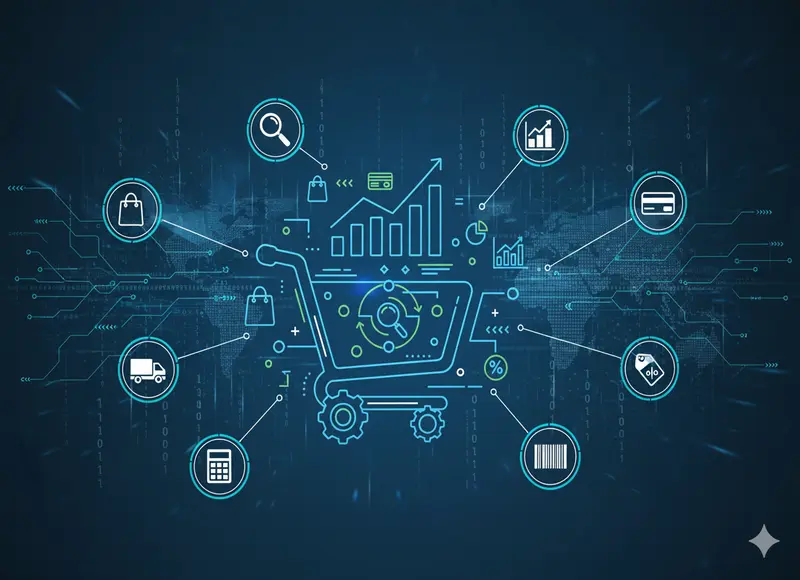Table of Contents
Machine learning is revolutionizing e-commerce—powering personalization, precision pricing, and data-driven growth. See how smart algorithms are transforming the way businesses connect with customers.

The rapid growth of e-commerce has transformed the global retail landscape. From personalized recommendations to automated inventory management, the integration of machine learning (ML) has revolutionized how businesses operate, compete, and deliver value to customers. As the volume of online transactions, customer interactions, and digital footprints expands exponentially, e-commerce datasets platforms are leveraging ML algorithms to uncover patterns, predict trends, and make data-driven decisions.
This article explores how machine learning is shaping e-commerce analytics, enhancing personalization, optimizing pricing, improving demand forecasting, detecting fraud, and much more.
The Role of Machine Learning in E-commerce
Machine learning enables computers to learn from historical data and improve their performance without clear programming. In e-commerce domains, ML algorithms analyze a large-scale dataset-from the click of the user to the product images and reviews to buy history-to provide an individual insight.
Traditional data analytics focuses on descriptive insight (what happened), while machine learning extends it to the future and prescriptive analytics, which will be and the functions are likely to recommend. This change empowers e-commerce businesses to create a smart system that suits customers' needs and market dynamics in real time.
1. Personalized Recommendations
Personal recommendation is one of the most visual and impressive applications of e-commerce ML. Advanced ML modeling techniques are used by Amazon, eBay, and Netflix to analyze customer behavior and make recommendations on products that fit the preferences of the said parties.
These systems usually employ collaborative filtering, content-based filtering, or hybrid models:
- The collaborative filtering uses the same users' data to recommend products.
- Content-based filtering suggests items with which a user has already interacted.
- Hybrid systems connect to gain high accuracy and variety in recommendations.
For example, when a shopkeeper looks at a product, the ML algorithm immediately evaluates millions of data points - purchases, browsing patterns, demographic information - and generates personal suggestions. This approach significantly increases customer engagement, conversion rate, and average order price.
2. Dynamic Pricing Optimization
In a competitive online market, pricing is an important factor affecting consumer decisions. Dynamic pricing- The strategy of adjusting prices in real-time based on demand, competition, and market conditions is powered by machine learning models that continuously analyze data like:
- Rivalry Pricing
- Procurement Frequency
- Inventory Levels
- Seasonal Trends
- Customer Behavior
Using regression models, reinforcement learning, and time-series forecasting, e-commerce businesses can predict optimal value points that maximize both profit and customer satisfaction. For example, Airlines and ride-sharing platforms such as Uber use dynamic pricing algorithms that adjust the fare based on demand, day-to-day, and availability.
3. Customer Segmentation and Targeting
Machine learning also enhances customer division, allowing groups of users to allow businesses based on shared characteristics such as demographics, procurement history, and browsing behavior.
Traditional division methods often rely on predetermined categories, but ML can detect natural groups in data without a model, models-especially k-means clustering and hierarchical clustering, such as learning algorithms, automatically.
It enables highly targeted marketing campaigns. For example, an online retailer can identify a section of customers who often purchase environmentally friendly products and target them with permanent product promotion. Improvement in the result is marketing efficiency, the cost of customer acquisition is reduced, and stronger brand loyalty.
4. Demand Forecasting and Inventory Management
E-commerce requires efficient inventory management, where both overstocking and understocking can cause significant damage. Machine learning models play an important role in the forecast of demand, predicting how much each product will be required in the future.
Time-series models (such as Arima or Prophet) and deep learning architecture (such as LSTM-long short-term memory network) can capture complex seasonal patterns, holiday effects, and promotional effects. These models analyze historical sales data, economic indicators, and even weather trends to correctly estimate the future demand.
Consequently, businesses can adapt to the level of stock, reduce holding costs, and overall supply chain efficiency and customer satisfaction, and ensure transportation.
5. Fraud Detection and Risk Management
With an increase in online transactions, the detection of fraud has become an important concern for e-commerce platforms. Machine learning provides a strong defense mechanism by identifying suspicious patterns in real time.
Fraud activities fake accounts, payment frauds, or coupons, are often difficult to detect for misuse-subtle discrepancies that are difficult to detect for rules-based systems. ML algorithms, especially discrepancy detection, classification, and contingency of artists, can learn from previous events to identify unusual behavior.
For example, if a user suddenly purchases several high-value items from various cards or various IP addresses, the system can flag down or block the transaction. Continuous model retention ensures adaptability for new fraud techniques, increasing platform security and trust.
6. Emotion analysis and customer response
E-commerce companies receive a large amount of unnecessary data, as mentioned in reviews, ratings, and social media. Natural Language Processing (NLP) - One of the most important aspects of machine learning enables businesses to analyze this data for emotion analysis.
Understanding that the customer's response is positive, negative, or neutral, businesses can do:
- Identify product quality issues
- Monitor brand reputation
- Improve customer service strategies
For example, NLP models can process thousands of reviews to extract subjects such as "slow delivery" or "excellent packaging", helping businesses to improve operating operations. Advanced models such as transformers (BERT, GPT) provide a deeper insight compared to traditional keyword-based methods, providing reference convenience of human language.
7. Visual Search and Image Recognition
Machine learning also provides strength to visual discovery, allowing customers to upload an image and find a visually similar product. Using the Convolutional Neural Network (CNN), e-commerce platforms can analyze image features such as color, size, and texture to match items from their catalogs.
This innovation bridges the gap between online and offline shopping experiences. For example, a user who spots a stylish pair of shoes in a photo can upload the image to search for the same objects available online. The visual search improves the search for the product and enhances the user experience - especially for fashion and lifestyle retail vendors.
8. Chatbots and Virtual Assistants
Intelligent chatbots and voice assistants run by ML and NLP are changing e-commerce customer aid. These systems can handle questions about order status, product description, and 24/7 returns, which can reduce the need for human agents.
Advanced intellectual models understand references, intentions, and emotions, providing more natural and personal interactions. In addition, ML enables chatbots to continuously learn from previous conversations, improving accuracy and user satisfaction over time.
9. Supply Chain and Logistics Optimization
Beyond the customer-facing applications, the machine plays an important role in the back-end logistics of learning e-commerce. Algorithms optimize distribution routes, predict delays in shipments, and increase warehouse management.
For example, reinforcement learning models can determine the most efficient distribution routes considering traffic, fuel costs, and delivery windows. Predictive Analytics may also estimate disruption suppliers, allowing for delays or weather-related obstacles-active adjustment for the supply chain operations.
Challenges and Moral Thoughts
Despite its transformative power, the integration of ML in e-commerce comes with challenges.
- Data Quality and Privacy: ML models require large amounts of clean, reliable data, which must be collected and processed morally in compliance with privacy rules such as GDPR.
- Model Lecturer: Businesses should ensure how the algorithm decides, especially for pricing and recommendations.
- Prejudice and Fairness: Biased data can give rise to inappropriate consequences, such as misinformation in discriminatory pricing or recommendations.
To address these challenges, strong data governance, continuous model monitoring, and human inspection are required.
Conclusion
Machine learning has become the backbone of modern e-commerce analytics, which makes clever decisions, personal experiences, and improves operational efficiency. Recommended engine and dynamic pricing demand fraud prevention and forecast, ML application spreads every aspect of the e-commerce ecosystem.
As the technology continues to develop-with progression progresses, generic AI, and real-time analytics-e-commerce will be even more intelligent, adaptive, and customer-centered. Businesses that embrace these innovations not only gain a competitive lead but also create a more attractive, skilled, and trusted digital marketplace.
Recent Blogs
12 Best MethStreams Alternatives for Safe and Reliable Sports Streaming in 2026
-
18 Dec 2025
-
12 Min
-
36
Real World Digital Transformation Use Cases in Real Estate, Tech, and Recruiting
-
17 Dec 2025
-
6 Min
-
144








